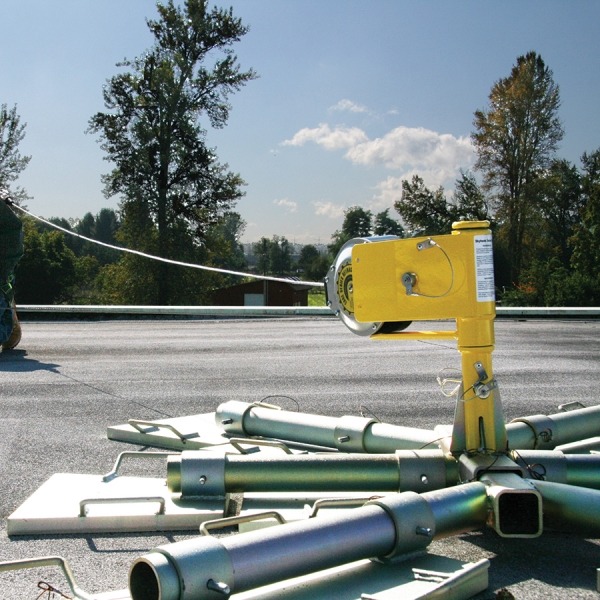Top 5 Hazards to Avoid When Using Portable Fall Arrest Anchors

 In the past few years multiple fall protection manufacturers have developed weighted base portable fall arrest anchorages to be used on flat, low sloped roofs or other elevated work sites. Typically these anchorages are brought to the roof in small sections and assembled at the location where they will be used. The small pieces make it easy to bring the anchor through roof hatches or hoist to the roof surface.
In the past few years multiple fall protection manufacturers have developed weighted base portable fall arrest anchorages to be used on flat, low sloped roofs or other elevated work sites. Typically these anchorages are brought to the roof in small sections and assembled at the location where they will be used. The small pieces make it easy to bring the anchor through roof hatches or hoist to the roof surface.
With well trained personnel these anchors provide an excellent safe guard against fall hazards by giving the user a portable anchorage option that can be set up in a variety of locations. The sections are typically light enough that one or two workers can set an anchorage up in just a few minutes.
Unfortunately, with all fall protection equipment there are limitations and severe dangers when the equipment is used incorrectly. All of these anchors will be shipped with user directions and information warning users of the dangers associated with the product but after the unit is assembled for the first time where does that literature end up? Did the person assembling the anchor even read the warnings? Below we list some of the major dangers associated with these portable anchors and how to avoid those hazards.
1. Untrained users. Just like with all fall protection equipment, users must be trained in the fall hazards they are exposed to in the work place and the methods for mitigating those hazards. If portable weighted base anchors are used to safeguard employees they must be trained on the proper assembly, use and limitations for that particular anchor and connecting devices (lanyards, SRL’s, rope and grabs). Untrained personnel is the number one problem we see in the work place when it comes to fall protection and is most likely the leading cause of death as well.
2. Set too close to the edge. Depending on the connecting device used, a worker must keep the anchor back from the edge of the roof a distance that will not allow them to free fall more than the OSHA allowable 6’. For example, when using a 6’ lanyard the anchorage should be kept back from the edge a distance of approximately 7’; which would allow the worker to reach the edge of the roof but not step off (fall restraint). If set up less than 7’ the worker will be exposed to a free fall the distance of their back d-ring to the ground plus the length of the slack in the lanyard. In most cases this will put them over the limit of 6’ total free fall and create a much greater chance of equipment failure.
3. Using a non-leading edge self-retracting lifeline. Standard self-retracting lifelines (SRL’s) are constructed to limit free fall distance to less than 2’ and limit arresting forces on the body to 900lbs. This can only be achieved by positioning the SRL above the user’s back d-ring. Portable weighted base anchors are almost always assembled on the roofs surface below the back d-ring. This would always put the free fall distance above the allowable 2’ maximum. Most of the major fall protection manufacturers have corrected this problem by developing “Leading Edge Self-Retracting Lifelines”. This type of SRL will have an external rip stich shock absorber positioned just after the snap hook and should be worn at the users back d-ring. The shock pack will limit the forces on the worker and SRL to less than 900lbs and protect the SRL from much larger dynamic loading. When using any SRL below your back d-ring ensure that it has an external shock pack.
4. Multiple users on one anchor. In most cases these anchors are designed to provide fall protection to a single worker. We have seen many cases where two, three and even four workers have all been connected to the same anchor at the same time. The literature that is provided with the anchor will describe the amount of workers allowed to connect to the anchorage at the same time.
5. Using horizontal lifelines connected to two anchors. Some manufacturers do allow the use of a horizontal lifeline (HLL) connected to two of their portable anchors but some do not. “Off the shelf” pre-engineered HLL’s can also be tricky and require quite a bit of training in order to be used safely. In most cases they also require a 5,000lb anchorage at each end; which portable anchors may not provide. If using a HLL with portable anchors ensure that they have been designed and engineered for such use and that the HLL you are using is combatable with the anchorages. Ensure that the users have adequate training for both types of systems.
When used correctly and with the right training, portable fall arrest anchors are a great way to provide a safe fall protection system for personnel when the situation allows.
Fill out the form on our contact page or call us today for more information on a Portable Anchors for your worksite: Toll-Free (855) Ver-Fall or (855) 837-3255.
